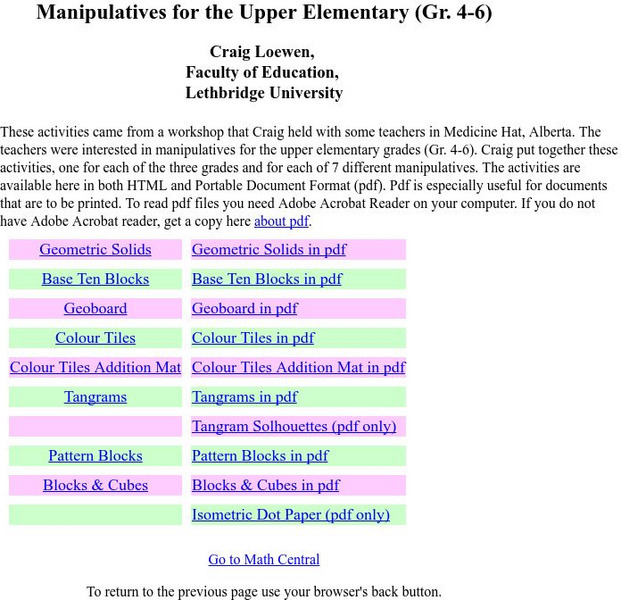Curated OER
Tessellations
Students identify shapes that will tessellate. They construct a tessellation using transformations. Students identify transformations in tessellations. They identify applications of transformations such as tiling and fabric design.
Curated OER
Compare 2-D Shapes
Second graders explore and analyze plane shapes. In this plane shapes instructional activity, 2nd graders evaluate shape attributes to classify shapes correctly. Students work in groups to create different shapes.
Curated OER
Tessellations Lesson
Fifth graders demonstrate their understanding of tessellations by watching a teacher prepared Powerpoint presentation and completing an activity. The students work independently to identify tessellations.
Curated OER
ARE YOU A TRIANGULATEER?
Students explore about triangles and their relationship to the worlld around them. They are able to identify triangular shapes in their environment. Students are able to communicate to one another their understanding of triangles outside...
Curated OER
Interior/Exterior Polygon Angles and Tessellations
Students discover the sum of the interior and exterior angles of several polygons. For this Geometers sketchpad lesson, students work in groups to find the stated measurements of triangles, quadrilaterals, pentagons and hexagons....
Curated OER
Count The Letters
Students perform activities involving ratios, proportions and percents. Given a newspaper article, groups of students count the number of letters in a given area. They use calculators and data collected to construct a pie chart and bar...
Curated OER
Tantalizing Tessellations - Lesson I
Students complete a chart (KWL) as a pre-assessment, study the history of tessellations (tilings), investigate the properties of tessellations, and make and evaluate photographs of "found tessellations" for a PowerPoint/HyperStudio...
Curated OER
African Ceremonial Masks
Fourth graders examine and discuss the purposes and traditions of African ceremonial masks. They design and create African ceremonial masks using various materials.
Curated OER
It Counts
Young scholars explore one to one number correspondence. In this early math lesson, students make observations about and classify plants in order to gain an understanding of using numbers to describe their world.
Curated OER
And The Twelfth One Is
Ninth graders play guess my shape (either describe or use a feely bag to introduce the 3 shapes in the problem.) As they are identified put them in an order as shown in the problem. As the students work on the problem in pairs teacher...
Curated OER
Watch It Slide!
Learners work together to examine inclined planes. They create a plan to raise rocks to build pyramids. They discover the changes that occur when the angle is increased or decreased.
Curated OER
Shapes at Work
Learners use their classroom to look for various types of shapes. In their science journals, they record the shapes they find and identify those that can be used to solve problems or build structures. They share and post their sketches...
National Council of Teachers of Mathematics
The Math Forum: Making Patterns
Explore the literature connections, online activity, pencil and paper activity, and the manipulative investigation of patterns and geometric shapes on this page!
Other
Interactive Pattern Blocks
A colorful, engaging site where students can manipulate pattern blocks to create patterns or pictures. Included in the detailed directions are possible activities and a feature that allows you to email your patterns to a friend.
University of Regina (Canada)
University of Regina: Math Central: Manipulatives for the Upper Elementary (Gr. 4 6)
Many teachers find it more challenging to incorporate the use of manipulatives into their mathematics programs at the upper elementary or middle school grades. Activities using manipulatives are provided for grades four, five, and six...
National Council of Teachers of Mathematics
The Math Forum: Building Shapes
Based on building a hexagon, this activity from the Math Forum collection focuses on using different combinations of pattern blocks to create a hexagon. An online activity, pencil and paper method, literature connections, and a...
National Council of Teachers of Mathematics
The Math Forum: Line Symmetry
This site from The Math Forum is a great site if you are looking for activities to engage your students in learning about line symmetry. Peruse this collection of activities for one or two or four that would be right for your students....
PBS
Pbs Mathline Lesson: Geometry, It's a Perfect Fit [Pdf]
This two-part geometry lesson plan has students identify, describe, and classify two-dimensional shapes. Students engage in hands-on activities including identifying shapes in the classroom, creating patterns with shapes, identifying...
National Council of Teachers of Mathematics
The Math Forum: Rotational Symmetry
This is a good site for elementary teachers to help educate students about symmetry by using pattern blocks. This link has multiple activities that the instructor could use including technological and standard activities.
ClassFlow
Class Flow: Pattern Block Template Shapes
[Free Registration/Login Required] This flipchart provides a review of circle, rectangle, square, triangle, and hexagon and introduces trapezoid and rhombus. Students are asked to identify the number of sides and the number of corners of...
Better Lesson
Better Lesson: Well That's Different!
Finding different combinations to cover a given pattern block is the idea of the day. Students will create pattern block shapes using other pattern blocks.
Better Lesson
Better Lesson: Assessing Composing and Decomposing Shapes
Knowledge in Action! Today you will find out if the students are understanding the idea of decomposing and composing shapes with pattern blocks.
National Council of Teachers of Mathematics
The Math Forum: Bricks Activity, Teacher Lesson Plan
Builders of brick walls need to be especially aware of fault lines which can easily lead to the collapse of the wall. Students are challenged, here, to use polyminoes to design patterns for brick walls which do not contain fault lines....
George Mason University
Handmade Manipulative Instructions
At this personal site, you will find pages of math manipulatives and different types of graphing paper to print out and use in your classroom.

















![Pbs Mathline Lesson: Geometry, It's a Perfect Fit [Pdf] Lesson Plan Pbs Mathline Lesson: Geometry, It's a Perfect Fit [Pdf] Lesson Plan](https://static.lp.lexp.cloud/images/attachment_defaults/resource/large/FPO-knovation.png)



